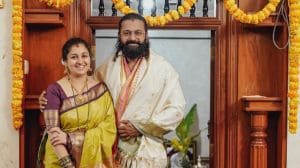Yoga is probably India’s top cultural export. Having originated in India thousands of years ago, this mind-body-soul practice has travelled far and wide, transcending the country’s borders and, hence, transforming into newer forms. As the world is gearing up for the ninth International Day of Yoga on June 21, let us explore some international variants of this traditional Indian practice.
Gym essentials
If there is a form of yoga that has truly made its way to the gyms, it is power yoga. Rooted in the traditional Ashtanga yoga, power yoga is said to have originated in the United States. Los Angeles-based Bryan Kest and New York-based Beryl Bender Birch, who had studied under Ashtanga guru K Pattabhi Jois, are often credited with the invention of this yoga form.
Also read: Leos to Scorpions: Cheers to these whiskies according to your Zodiac sign
A more vigorous and less meditative form, “power yoga involves burning a lot of calories in a workout,” says Sarvesh Shashi, CEO and founder of SARVA Yoga, a Chennai-headquartered one-on-one virtual personal training platform. It involves flowing from one pose to the next at a fast pace rather than approaching each separately. It is safe to say, power yoga can be attributed to bringing yoga to the gyms. “You can burn up to 400 calories in just one workout. And who does not want to burn calories that fast?” says Shashi over the popularity of power yoga.
Although popular in the west, many yoga practitioners and gurus hold a tough stance. “India’s traditional yoga focuses on physical postures, breathing exercises, meditation and spiritual development. But regarding power yoga, I have concerns about its overemphasis on physical strength and fitness, potentially neglecting the spiritual and meditative aspects of yoga,” says Hansaji Yogendra, director of The Yoga Institute, a Mumbai-headquartered non-profit yoga centre.
A quiet affair
The opposite of power yoga is yin yoga. As evident from the moniker, it is based on the Chinese principle of yin. While yang represents the more vigorous kinds—Ashtanga, Vinyasa, power, etc, yin is the slower kind, where the emphasis is on stretching the deep connective tissue. Martial arts expert and Taoist yoga guru Paulie Zink is often attributed as the founder of the form. It developed somewhere around the 1970s, as per reports.
Not just outside India, “yin yoga is quite popular with us as well. It is especially popular among those practitioners who like a quiet, contemplative practice,” says Shashi. Since it is inspired by traditional Chinese medicine and was invented by a martial arts practitioner, “you can imagine the intense focus on the poses. The holds in yin yoga are longer and that makes it more challenging,” the expert elaborates.
Yin yoga is perfect for anyone looking for a deeper, meditative practice as long as “there are no serious injuries, chronic disorders, recent surgeries or pregnancies,” Shashi adds.
Team spirit
This one requires a partner. As the name suggests, ‘acro yoga’ is a mix of yoga, acrobatics, and often elements of Thai massage, too. It was developed in 2003 by Jenny Sauer-Klein and Jason Nemer, a dancer and a yoga practitioner, respectively. The duo describes the form as “a movement practice that combines the balance of yoga, the fitness of acrobatics and the healing potential of human connection”. On their website, they say practitioners come for all kinds of reasons—“as a long-term solution to chronic pain; to increase mobility, lose weight and gain muscle mass; to make friends or deepen relationships”.
It is practised with a partner, and at times, a third person. Hence, the person who does the lifting becomes the base, the one being lifted is the flyer and the third person is for assisting and to ensure safety.
Acro yoga involves two kinds of practices—solar and lunar. While practising the former, both the base and the flyer are active, making it a powerful, dynamic and playful practice. Lunar, on the other hand, is more therapeutic and involves elements of Thai massage, making it more about healing and letting go.
Also read: Father’s Day Escapes: 6 tailored travel adventures for every dad
However, it “involves partner-based acrobatic movements and sequences, which I believe may overshadow the deeper aspects of yoga,” says Yogendra. “Traditional yoga is a personal journey of self-discovery and self-reliance, and the dependency on a partner in acro yoga may hinder the individual’s connection with their own inner self. The complex and physically demanding movements in acro yoga can pose a risk of injury if practised without proper guidance and precautions,” she adds.
Warming up
Then there is ‘hot yoga’, practised in a hot environment, somewhere around 27-38°C. While this form and Bikram yoga, developed by disgraced teacher Bikram Choudhury, are often used interchangeably, differences exist. Long story short, every Bikram yoga is hot yoga, but the opposite is not true.
Doing yoga in a heated environment is challenging, but it comes with its share of benefits. Research suggests that men can burn up to 460 calories, and women 330, during a Bikram yoga session of 90 minutes. It could also have a positive impact on heart health, as suggested by a 2014 study, according to which, a session of hot yoga can make the heart pump at the same rate as a brisk walk. It could also help with diabetes. A study published in 2013 found that Bikram yoga helped with improving glucose tolerance in obese older adults. However, the impact was found to be less on young and lean adults.
However, there can be some concerns. “In hot yoga, there is often an excessive emphasis on external heat. The heated room temperatures can stress the body and potentially lead to dehydration or overexertion,” says Yogendra.
It’s in the air
“Aerial yoga is hands down the most popular form of yoga amongst beginners,” says SARVA Yoga’s Shashi. “It is also admittedly quite an enjoyable form of yoga. The feeling of defying gravity in a safe space is exhilarating. It is gaining popularity rapidly,” he adds.
As the name suggests, aerial yoga is practised suspended from a hammock or yoga swing. Christopher Harrison, a dancer with a background in acrobatics, is credited with creating the form in New York. Essentially, it is a combination of traditional yoga, acrobatics, pilates and dance, making it a fun and fluid.
“The biggest benefit of aerial yoga is that it helps decompress the spine, along with with relaxation. At the same time, the more intense asanas (poses) can build core and lower body strength. It also makes deep stretches accessible to beginners,” explains Shashi. However, “those who feel dizzy very easily or feel afraid while being off the ground should try it with caution,” he says.
Pregnant women and those with vertigo are recommended not to do this form.
Water world
Yoga is also performed in water and, hence, is called aqua yoga. “Aqua yoga offers several benefits including reduced impact on joints. Practising yoga in water provides a supportive environment, reducing strain on the joints and offering resistance to challenge the muscles in a unique way,” says Yogendra.
Other benefits include “improved flexibility and range of motion, increased muscle strength and endurance, enhanced relaxation and stress relief, and better balance and stability,” adds Shashi.
Despite its benefits, it may not be suitable for everyone and “individuals with certain medical conditions cannot practise it,” says Yogendra. Also, “it should be practised under the guidance of a coach and should be avoided if there’s anxiety/stress related to water bodies,” adds Shashi.
A global phenomenon
Yin Yoga
It is based on the Chinese principle of yin. It is suitable for those looking to balance their vigorous workouts with deeper practice. American martial arts expert and Taoist yoga guru Paulie Zink is
often attributed as the founder of the form
Acro Yoga
It is a mix of yoga, acrobatics and often elements of Thai massage. It is a fun workout and is done with a partner. It was developed in 2003 by Jenny Sauer-Klein and Jason Nemer, a dancer and a yoga practitioner, respectively, in the US
Aqua Yoga
This form is performed in water. While some find it harder, others say the medium acts differently than floor and air. However, it is easy on the joints, making it ideal for those with joint pain
Hot Yoga
It is practised in a hot environment, somewhere around 27-38°C. Men can burn up to 460 calories and women 330 with this form of yoga. It can also have a positive impact on heart health and help fight diabetes, say reports
Power Yoga
Rooted in the traditional Ashtanga yoga, this form of yoga is said to have originated in the US. A more vigorous and less meditative form, power yoga involves burning a lot of calories in a workout. A gym favourite
Aerial Yoga
It is the most popular form of yoga among beginners. It is practised suspended from a hammock or yoga swing. Christopher Harrison, a dancer with a background in acrobatics, is credited with creating the form in New York









